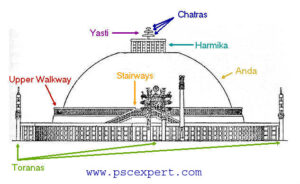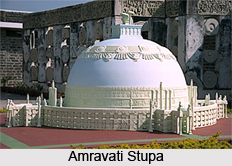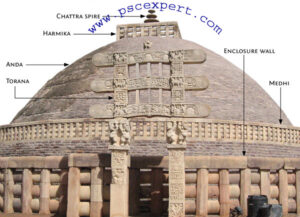INDIAN ARCHITECTURE
INDUS VALLEY CIVILIZATION
- traced as far back as third millennium BC.
- on the banks of the river Indus particularly at the bends that provided water, easy means of transportation of produce and other goods and also some protection by way of natural barriers of the river .
- consisted of walled cities which provided security to the people.
- rectangular grid pattern of layout with roads that cut each other at right angles.
- used standardised burnt mud-bricks as building material.
- evidence of building of big dimensions which perhaps were public buildings, administrative or business centres, pillared halls and courtyards.
- no evidence of temples.
- granaries which were used to store grains which give an idea of an organised collection and distribution system.
- ‘Great Bath’ – public bathing place shows the importance of ritualistic bathing and cleanliness in this culture. It is still functional and there is no leakage or cracks in the construction.
- most of the houses had private wells and bathrooms.
- dominant citadal – treated as evidence of some kind of political authority ruling over the cities.
- evidence also of fortifications with gateways enclosing the walled cities which shows that there may have been a fear of being attacked.
Dholavira , Rangpur, Rojdi, Lothal , Sarkotada , Kuntasi, Padri (Gujarat) Kalibangan (Rajasthan), Bhagwanpura, Banawali (Haryana), Diamabad (Maharashtra), Alamgirpur (U.P.), and Mauda (Jammu).
THE MAURYAN PERIOD
- Ashoka, first Mauryan to “think in stone”.
- most of the shapes and decorative forms employed were indigenous in origin, some exotic forms show the influence of Greek, Persian and Egyptian cultures.
- beginning of the Buddhist School of architecture in India.
- monolithic Ashokan pillars are marvels of architecture and sculpture. These were lofty free standing monolithic columns erected on sacred sites. Originally there were about thirty pillars but now only ten are in existence, of which only two with lion capitals stand in situin good condition at Kolhua and Laurya Nandangarh respectively.
- Sarnath pillar – finest pieces of sculpture of the Ashokan period.
- Two Ashokan edicts – found at Laghman, near Jalalabad ( Afghanistan).
- most important ones are located at Bharhut, Bodhgaya, Sanchi, Amravati and Nagarjunakonda.
- Chinesetraveller Fa-hien stated that “Ashoka’s palace was made by spirits” and that its carvings are so elegantly executed “which no human hands of this world could accomplish”.
- Its existence was pointed out during the excavations at Kumrahar, near Patna, where its ashes have been found preserved for several thousand years.
- Megasthenes, the Greek ambassador of Selucas Nikator who visited the Mauryan court described Chandragupta Maurya’s palace as an excellent architectural achievement.
THE STUPAS

SANCHI STUPAS:
- hemispherical in shape with a low base.
- symbolized the cosmic mountain.
- inscription by the ivory carvers of Vidisha on the southern gateway throws light on the transference of building material from perishable wood and ivory to the more durable stone.
AMARAVATI STUPA:

- built in 2nd or 1st century BC was probably like the one at Sanchi
- but in later centuries it was transformed from a Hinayana shrine to a Mahayana shrine.
GANDHARA STUPA:
- further development of stupas at Sanchi and Bharhut.
- the base, dome and the hemisphere dome are sculpted.
- stupasof Nagarjunakonda in Krishna valley were very large.
- Maha Chaitya ofNagarjunakonda has a base in the form of Swastika, which is a sun symbol.


